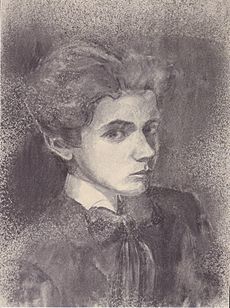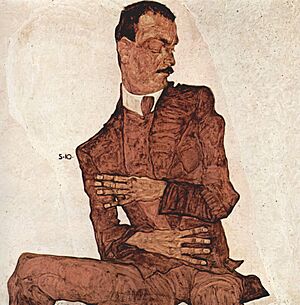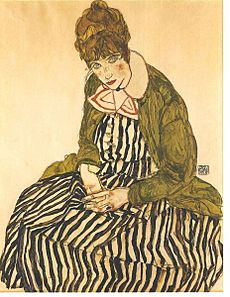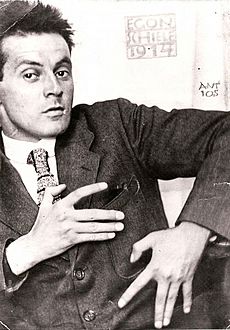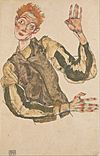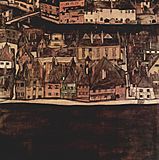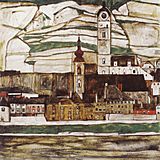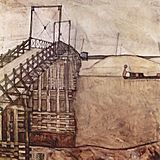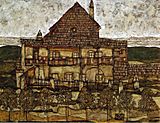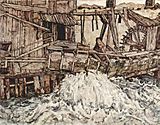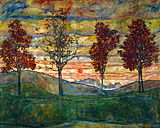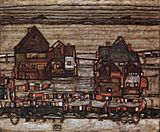Egon Schiele facts for kids
Quick facts for kids
Egon Schiele
|
|
|---|---|
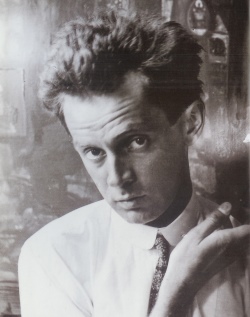
Photograph of Egon Schiele, 1910s
|
|
| Born | 12 June 1890 Tulln an der Donau, Austro-Hungarian Empire
|
| Died | 31 October 1918 (aged 28) |
| Nationality | Austrian |
| Education | Akademie der Bildenden Künste |
| Known for | Painting, drawing, printmaking |
|
Notable work
|
|
| Movement | Expressionism |
Egon Schiele (born June 12, 1890 – died October 31, 1918) was an Austrian painter. He is known for his unique and powerful style, which is part of the Expressionism art movement. Schiele's art often showed strong emotions and feelings. He created many self-portraits and paintings of people, often showing them in unusual poses. Even though he died very young, his work had a big impact on the art world.
Contents
Biography
Early Life and Art Beginnings
Egon Schiele was born in 1890 in Tulln, Austria. His father worked as a station master for the railway. As a child, Egon loved trains and spent hours drawing them. He was so focused on art that his father sometimes destroyed his sketchbooks.
When he was 11, Schiele moved to attend secondary school. People around him thought he was a bit strange. He was shy and quiet. He didn't do well in most school subjects, but he was very good at sports and drawing.
Studying Art
When Schiele was 14, his father passed away. His uncle, Leopold Czihaczek, became his guardian. Although his uncle wanted him to work on the railway, he saw Egon's talent for drawing. So, he allowed Egon to have an art tutor.
In 1906, Schiele applied to the School of Arts and Crafts in Vienna. This was where famous artist Gustav Klimt had studied. After his first year, Schiele was encouraged to move to the more traditional Academy of Fine Arts Vienna. His main teacher there, Christian Griepenkerl, had very strict and old-fashioned ideas about art. Schiele and his classmates felt frustrated by this. Because of this, he left the Academy three years later.
Meeting Gustav Klimt
In 1907, Schiele met Gustav Klimt, a very famous artist who often helped younger artists. Klimt was especially interested in Schiele's work. He bought Schiele's drawings, offered to trade his own art for them, and helped Schiele find models. Klimt also introduced Schiele to people who might buy his art.
Schiele's early paintings, from 1907 to 1909, show a strong influence from Klimt and the Art Nouveau style. In 1908, Schiele had his first art show. In 1909, after leaving the Academy, he started a group called Neukunstgruppe ("New Art Group") with other students who were also unhappy with traditional art teaching.
Schiele took part in many art shows. He showed his work with the Neukunstgruppe in Prague and Budapest. He also exhibited in Cologne and Munich. In 1911, Schiele met Walburga (Wally) Neuzil, who became a model for some of his most famous paintings.
World War I and Later Life
In 1914, Schiele met Edith Harms. In 1915, Schiele and Edith were married. Just three days after his wedding, World War I began to affect his life. Schiele was ordered to join the army.
During the war, Schiele's paintings became larger and more detailed. His army duties meant he had less time to paint. So, much of his art from this period was drawings of landscapes and military officers. He also began to explore themes of motherhood and family in his art.
Even with his military service, Schiele continued to show his art in Berlin, Zürich, Prague, and Dresden. At first, he guarded Russian prisoners. Later, because of his good handwriting and a weak heart, he became a clerk in a prisoner-of-war camp. His commander even gave him a room to use as a studio. This allowed him to draw and paint the imprisoned officers.
By 1917, Schiele was back in Vienna and could focus more on his art. He created many new works, showing how much his skills had grown. He was invited to a major art exhibition in Vienna in 1918. Schiele had fifty of his works shown in the main hall. He also designed the poster for the exhibition. The show was a huge success, and the prices for his drawings went up. He also received many requests for portraits.
In the autumn of 1918, the Spanish flu spread to Vienna. Edith, who was pregnant, died from the illness on October 28. Egon Schiele died just three days later, at the age of 28. In the short time between their deaths, Schiele drew a few sketches of Edith.
Art Collections
The Leopold Museum in Vienna has a very important collection of Schiele's work. It includes over 200 pieces. In 2011, the museum sold one of his paintings, Houses With Colorful Laundry (Suburb II), for over $40 million. Other places where you can see Schiele's art include the Egon Schiele-Museum in Tulln, the Österreichische Galerie Belvedere, and the Albertina Graphic Collection, all in Vienna.
Self-portraits
Landscapes
Images for kids
See also
 In Spanish: Egon Schiele para niños
In Spanish: Egon Schiele para niños


